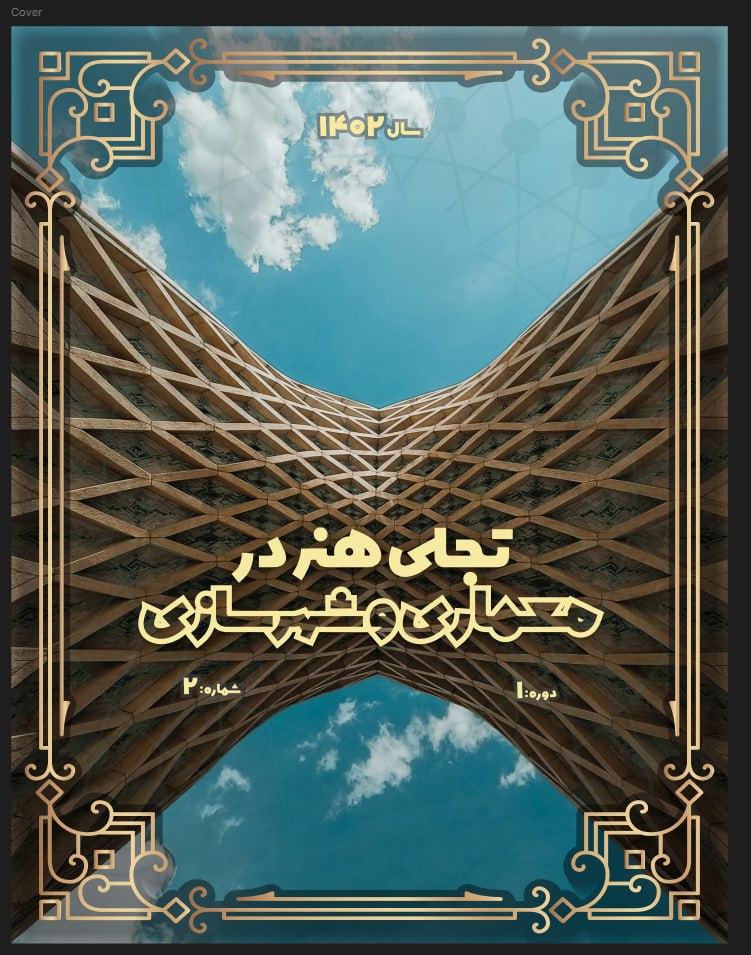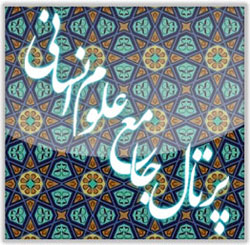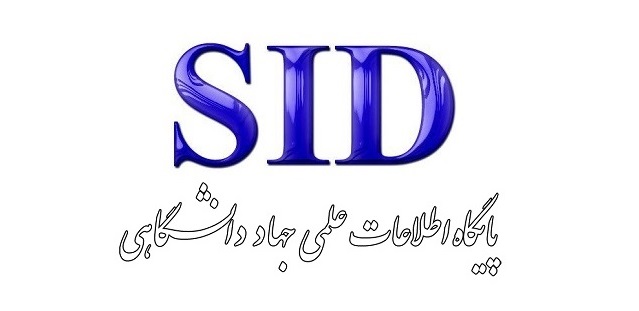شناسایی مؤلفههای کالبدی مؤثر بر شکلگیری مکان سوم: مقایسه بازار تاریخی و مجتمع تجاری لاله پارک تبریز
کلمات کلیدی:
مکان سوم, کیفیت فضاهای عمومی, مدل مفهومی مکان, مؤلفههای کالبدی, تعاملات اجتماعیچکیده
این پژوهش با هدف شناسایی و تحلیل مؤلفههای کالبدی مؤثر بر شکلگیری و ارتقای کیفیت «مکان سوم» در فضاهای شهری، از طریق مطالعه تطبیقی بازار تاریخی و مجتمع تجاری لالهپارک تبریز انجام شده است. پژوهش حاضر مبتنی بر رویکرد کیفی و روش تحلیل محتوای نظاممند است. ابتدا ادبیات علمی مرتبط با کیفیت مکان، نظریههای مکان سوم، و مدلهای معتبر بینالمللی و بومی گردآوری و کدگذاری شد. فرایند تحلیل دادهها در سه مرحله کدگذاری باز، محوری و انتخابی با استفاده از نرمافزار MaxQDA انجام گرفت. سپس چارچوب مفهومی اولیه تدوین و در بستر مطالعه تطبیقی دو نمونه موردی (بازار تاریخی تبریز و مجتمع تجاری لالهپارک) آزمون شد تا ابعاد کالبدی، عملکردی، اجتماعی و ادراکی مکان سوم شناسایی و سازماندهی شود. نتایج نشان داد مؤلفههای کالبدی شامل مقیاس انسانی، انعطافپذیری فضایی، دسترسیپذیری، کیفیت نور و دید، طراحی مبلمان، مرزبندی فضایی و حس امنیت نقش بنیادین در ارتقای کیفیت تجربه مکانی و تقویت تعاملات اجتماعی دارند. بازار تاریخی تبریز به دلیل ساختار فضایی پیچیده و هویت فرهنگی-تاریخی، حس تعلق و پویایی اجتماعی بیشتری ایجاد میکند، در حالیکه مجتمع تجاری لالهپارک با وجود امکانات مدرن، از نظر تعاملات خودجوش اجتماعی و پیوند عاطفی ضعیفتر عمل میکند. پژوهش حاضر با ارائه یک مدل مفهومی جامع، نشان میدهد موفقیت مکان سوم تنها وابسته به طراحی فیزیکی نیست و نیازمند توجه همزمان به ابعاد اجتماعی، روانی و فرهنگی است. این مدل میتواند بهعنوان ابزاری کاربردی برای طراحان و برنامهریزان شهری در خلق فضاهای عمومی پویا، انسانمحور و هویتبخش مورد استفاده قرار گیرد.
دانلودها
مراجع
1. Habibi SM. Civil Society and Urban Life. Journal of Fine Arts. 2008;7.
2. Putnam RD. Bowling Alone: The Collapse and Revival of American Community: Simon & Schuster; 2000.
3. Oldenburg R. The Great Good Place: Café's, Coffee Shops, Community Centers, Beauty Parlors, General Stores, Bars, Hangouts, and How They Get You Through the Day: Marlowe & Company; 1999.
4. Montgomery J. Community strengthening through urban sociability. 2006.
5. Klinenberg E. Palaces for the People: How Social Infrastructure Can Help Fight Inequality, Polarization, and the Decline of Civic Life: Crown Publishing; 2018.
6. Williams SA, Hipp JR. How great and how good? Third places, neighborinteraction, and cohesion in the neighborhood context. Journal of Social Science Research. 2019;77:68-78.
7. Daneshpour A. Re-recognition of the Concept of Identity in Urban Public Space (Street); Case Study: Enghelab Street, Tehran: University of Tehran; 2000.
8. Behzadfar M. Identity of the City: A Look at the Identity of Tehran City. Tehran: Shahr Publications; 2008.
9. Carmona M. Public places urban spaces: The dimensions of urban design: Routledge; 2021.
10. Golkar K. The Creation of Sustainable Place. Tehran: Shahid Beheshti University; 2012.
11. Sandelands LE. Thinking about social life. Lanham, MD: University Press of America, Inc.; 2003.
12. Gehl J. Cities for People: Island Press; 2010.
13. Ching FD. Architecture: Form, space, and order: John Wiley & Sons; 2023.
14. Falahat MS, Samad S. The Role of the Solid-Void Concept in Explaining Architectural Place. Bagh-e Nazar Journal. 2015(35):27-38.
15. Zevi B. How to Look at Architecture. Tehran: Shahidi; 2008.
16. Behzadfar M, Jalili Sadrabad S, Jalili Sadrabad S. Lighting of Urban Public Spaces and Women's Presence; Case Study: Saei Park, Tehran. Armanshahr Architecture and Urban Planning. 2013;7:93-100.
17. Mojtabavi SM, Namdar F, Azadioun H. Investigating Effective Factors on Creating and Promoting Place Attachment in Iranian Public Libraries. Ferdos-e Honar. 2020;1(2):82-107.
18. Carmona M, Tiesdell S, Heath T, Oc T. Public Places - Urban Spaces: The Dimensions of Urban Design: Routledge; 2010.
19. Lynch K. The Image of the City: MIT Press; 1960.
20. Shojaei D, Partovi P. Effective Factors for Creating and Promoting Sociability in Public Spaces with Different Scales of Tehran City (Case Study: Public Spaces of Two Neighborhoods and One District in District 7 of Tehran). Bagh-e Nazar Journal. 2015;12(34):93-108.
21. Asgari A. A Comparison of the Mental Model of Architects and Users to Increase Sense of Belonging to Place in Social Commercial Spaces. Case Studies: The Café-Restaurant Areas of Royal and Golestan Complexes in Shahrak-e Gharb, Tehran. Armanshahr Architecture and Urban Planning. 2023;16(42):135-44.
22. Chena Z, Dong B, Pei Q, Zhan Z. The impacts of urban vitality and urban density on innovation: Evidence from China's Greater Bay Area. Habitat International. 2022.
23. Golkar K. An Exploration into the Definition of Urban Design. Tehran: Center for Urban and Architectural Studies and Research of Iran; 2008.
24. Daneshpour SS. An Analysis of Physical Factors Affecting the Sense of Belonging to Place in the Old Center of Sabzevar City. Scientific-Research Quarterly of Urban Research and Planning. 2018;9(33):125-36.
25. Lang J. Creating Architectural Theory: The Role of the Behavioral Sciences in Environmental Design. Tehran: University of Tehran Publications; 2002.
26. Carmona M. The Value of Urban Design: A research commissioned by CABE and DETR to examine the value added by good urban design. London, UK: Thomas Telford Ltd; 2001.
27. Gehl J. Life Between Building. New York1987.
28. Gehl J. Public spaces, public life. Copenhagen: Danish architectural press; 2004.
29. Hadidi Masouleh N. Placemaking and the Third Place: The Social Function of the Public Space in the Sagharisazan Design Axis, Rasht: Isfahan University of Art; 2012.
30. Nouri M. Explaining the Experience of Oldenburg's Third Place Transformation in the 21st Century: An Exploration into the Interaction Between the Virtual World and the Real World in the Context of Citizens' Leisure. Suffeh Journal. 2019;29(86):57-82.
31. Kim J, Klein-Balajee T, Kelly RM, Hiniker A. Discord's Design Encourages" Third Place" Social Media Experiences. arXiv preprint arXiv:250109951. 2025.
32. Khoshnam A. Phenomenology of Place in the Student Lifeworld (Case Study: Undergraduate Students of the University of Tehran). Iranian Journal of Higher Education. 2021;13(1):62-99.
33. Mills KG, Han FX, Zhang J, Changiz Rezaei SS, Chudak F, Lu W, et al., editors. Profiling neural blocks and design spaces for mobile neural architecture search. Proceedings of the 30th ACM International Conference on Information & Knowledge Management; 2021.
34. Gholipour, Hafezifar. Investigating Gender and Its Differences in the Perception of Urban Space. Shabak Journal. 2021;7(6):151-6.
35. Rahmani, Rafieepour. The Coffee Shop as a Peace-Oriented Place (Rethinking the System of Semantic Relations of the Coffee Shop). Applied Sociology. 2022;33(2):137-62.
36. Abedini S, Hasanloui. Urban Third Places; A Scene for Creating Social and Recreational Hangouts for the Community: A Comparative Study of Cafés in Districts 1 and 4 of Urmia City. Urban Planning Knowledge. 2021;5(2):153-70.
37. Partovi P. Phenomenology of Place. Tehran: Iranian Academy of the Arts; 2008.
38. Karami E, Basiri Z, Zeinali A. Analyzing Place Attachment and its Dependent Variables in Urban Third Places (Case Study: Eyl Goli Park, Tabriz). Urban Planning Geography Research. 2021;9(3):735-59.
39. Ramezani, Ghareh B, Minou, Moulaei. The Role of Third Places in Promoting Citizens' Sense of Belonging. Case Study: Valiasr Square to Valiasr Street Crossroads, Tehran. Rahpuyeh Architecture and Urban Planning. 2022;1(2):61-76.
40. Shakour, Abdollahzadeh F, Khorshidi. The Role of Physical Structure in the Formation of Social Cohesion in Urban Neighborhoods (Case Study: Ghasr-e Dasht Neighborhood, Shiraz). Scientific-Research Quarterly of Urban Research and Planning. 2018;9(33):85-96.
41. Davoudi A, Modiri A. Assessing the Dispersion of Third Places in Relation to Various Socioeconomic Classes in Zanjan City. Urban Studies. 2015;4(16):81-92.
42. Shokouhi Dehkordi K, Ghorbani Bafghi G, Soltani S, editors. Investigating the Role of the Third Place in Increasing Social Interactions and Improving Citizens' Leisure Time. Fourth Commission of Architecture, Urban Planning, and Sustainable Land; 2016.
43. Dibazar T, Jamali, Valizadeh. The Impact of the General Characteristics of Third Places on Social Interactions; Case Study: Cafés in Tabriz City. Quarterly Journal of Urban Studies. 2021;10(39):29-40.
44. Ziyari K, Nezami M, Pour Ahmad A. The Role of Third Places in the Social Dimension of Urban Areas. Case Study: Open-Air Cafes in District 2 of Tehran. Quarterly Journal of Urban and Regional Development Planning. 2019.
45. Nasehi, Saberi, Ghaed Rahmati S, Khadem al-Hosseini A. Urban Third Places and Social Sustainability of Neighborhoods in Isfahan City. Quarterly Journal of Future Cities Outlook. 2022;3(2):95-111.
46. Valenzuela-Levi N, Fuentes L, Ramirez Ml, Rodriguez S, Señoret A. Urban sustainability and perceived satisfaction in neoliberal cities. Journal of Cities. 2022;126:103647.
47. Davino C, Gherghi M, Sorana S, Vistocco D. Measuring social vulnerability in an urban space through multivariate methods and models. Social indicators research. 2021;157(3):1179-201.
48. Li H, Wu G, Zheng WS, editors. Combined depth space based architecture search for person re-identification. Proceedings of the IEEE/CVF conference on computer vision and pattern recognition; 2021.
49. Gehl J. The Human City: Royal Architecture Science Institute; 2013.
50. Hou N, Nishina D, Sugita S, Jiang R, Kindaichi S, Oishi H, et al. Virtual reality space in architectural design education: Learning effect of scale feeling. Building and Environment. 2024;248:111060.
51. Gehl J. Life Between Buildings. Tehran: University Jihad; 1988.
52. Pakzad J. Identity and Sameness with Space. Suffeh Journal. 1996(21).
53. Pakzad J. The Course of Thoughts in Architecture and Urban Planning.
54. Dolatyarian K, Yazdani G, Ghafari Gilandeh A, Nazmfar. Worship-Cultural Places as a Third Place: Explaining the Role of Mosques in the Social Sustainability of Khorramabad City. Space Planning and Geomatics. 2023;27(4):103-30.
55. Roushandel N, Soltani Fard H, Abbaszadeh S, Salmani Moghadam M. Analyzing the Dimensions of Environmental Quality Affecting the Presence of Commercial Spaces. Case Study: Rahnamayi Commercial Street, Mashhad. Urban and Regional Studies and Research. 2016;8(28):71-92.
56. Mohammadi, Rafiei B. Identifying Factors Affecting the Sense of Place Belonging of New City Residents with an Emphasis on Place Models and Its Evaluation in Andisheh New City. Welfare Planning and Social Development. 2021;12(48):187-229.
57. Lashkari G, Nouri A. Explaining and Measuring the Influential Aspects on Place Attachment in Children's Creativity Centers (Case Study: Children Aged 6 to 10 Residing in Shahrak-e Gharb Neighborhood, Tehran). Design and Planning in Architecture and Urban Planning. 2023;1(1):3-19.
دانلود
چاپ شده
ارسال
بازنگری
پذیرش
شماره
نوع مقاله
مجوز
حق نشر 2025 Sepideh Rafiei (Author); Shabnam Akbarinamdar

این پروژه تحت مجوز بین المللی Creative Commons Attribution-NonCommercial 4.0 می باشد.









